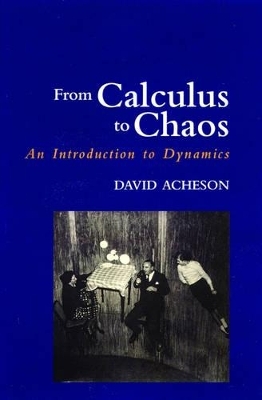
From Calculus to Chaos
An Introduction to Dynamics
Seiten
1997
Oxford University Press (Verlag)
978-0-19-850077-3 (ISBN)
Oxford University Press (Verlag)
978-0-19-850077-3 (ISBN)
What is calculus really for? It helps tell us how and why things change with time. This illustrated introduction to dynamics aims to inspire the interest and enthusiasm of students embarking on a course of mathematical study. It explains why the mathematics which students learn is useful, by exploring the central ideas of calculus and dynamics.
What is calculus really for? This book is a highly readable introduction to applications of calculus, from Newton's time to the present day. These often involve questions of dynamics, i.e. of how - and why - things change with time. Problems of this kind lie at the heart of much of applied mathematics, physics, and engineering. From Calculus to Chaos takes a fresh approach to the subject as a whole, by moving from first steps to the frontiers, and by highlighting only the most important and interesting ideas, which can get lost amid a snowstorm of detail in conventional texts. The book is aimed at a wide readership, and assumes only some knowledge of elementary calculus. There are exercises (with full solutions) and simple but powerful computer programs which are suitable even for readers with no previous computing experience. David Acheson's book will inspire new students by providing a foretaste of more advanced mathematics and showing just how interesting the subject can be.
What is calculus really for? This book is a highly readable introduction to applications of calculus, from Newton's time to the present day. These often involve questions of dynamics, i.e. of how - and why - things change with time. Problems of this kind lie at the heart of much of applied mathematics, physics, and engineering. From Calculus to Chaos takes a fresh approach to the subject as a whole, by moving from first steps to the frontiers, and by highlighting only the most important and interesting ideas, which can get lost amid a snowstorm of detail in conventional texts. The book is aimed at a wide readership, and assumes only some knowledge of elementary calculus. There are exercises (with full solutions) and simple but powerful computer programs which are suitable even for readers with no previous computing experience. David Acheson's book will inspire new students by providing a foretaste of more advanced mathematics and showing just how interesting the subject can be.
Dr D.J. Acheson Jesus College Oxford OX1 3DW Tel: 01865 279700 Fax: 01865 279687 Email: david.acheson@jesus.ox.ac.uk
Introduction ; A brief review of calculus ; Ordinary differential equations ; Computer solution methods ; Elementary oscillations ; Planetary motion ; Waves and diffusion ; The best of all possible worlds? ; Fluid flow ; Instability and catastrophe ; Nonlinear oscillations and chaos ; The not-so-simple pendulum ; Further reading ; Appendix A: Elementary programming in QBASIC ; Appendix B: Ten programs for exploring dynamics ; Solutions to the exercises ; Index
| Erscheint lt. Verlag | 28.8.1997 |
|---|---|
| Zusatzinfo | halftones, numerous line figures, tables |
| Verlagsort | Oxford |
| Sprache | englisch |
| Maße | 156 x 233 mm |
| Gewicht | 432 g |
| Themenwelt | Mathematik / Informatik ► Mathematik ► Analysis |
| Mathematik / Informatik ► Mathematik ► Angewandte Mathematik | |
| Naturwissenschaften ► Physik / Astronomie ► Mechanik | |
| Technik ► Maschinenbau | |
| ISBN-10 | 0-19-850077-7 / 0198500777 |
| ISBN-13 | 978-0-19-850077-3 / 9780198500773 |
| Zustand | Neuware |
| Haben Sie eine Frage zum Produkt? |
Mehr entdecken
aus dem Bereich
aus dem Bereich
Band 5: Hydraulik, Stromfadentheorie, Wellentheorie, Gasdynamik
Buch | Softcover (2024)
De Gruyter Oldenbourg (Verlag)
CHF 83,90


